The Economics and Statistics Division maintains archives of previous publications for accountability purposes, but makes no updates to keep these documents current with the latest data revisions from Statistics Canada. As a result, information in older documents may not be accurate. Please exercise caution when referring to older documents. For the latest information and historical data, please contact the individual listed to the right.
<--- Return to Archive
For additional information relating to this article, please contact:
December 29, 2021HOUSING STARTS, NOVEMBER 2021 With November reference month results, year-to-date comparisons (Jan-Nov 21 vs Jan-Nov 20) show rebounds in economic activity from the unprecedented declines observed at the start of the COVID-19 pandemic in 2020.
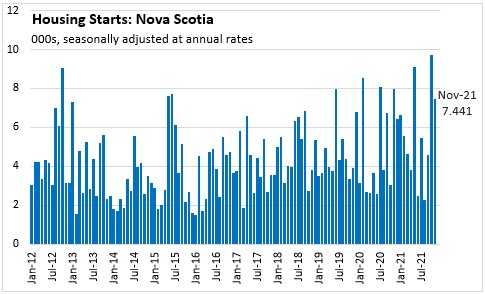
Nova Scotia’s housing starts (seasonally adjusted annualized rate) totalled 7,441 units in November 2021, down 23.4% from the recent monthly high for housing starts reported in October (seasonally adjusted annualized rate of 9,709).
Housing starts in Halifax decreased from a seasonally adjusted annualized pace of 8,197 units in October to 5,505 units in November (-32.8%).
Outside of Halifax, housing starts were up from a seasonally adjusted annualized rate of 1,512 units in October to 1,936 units in November (+28.0%).
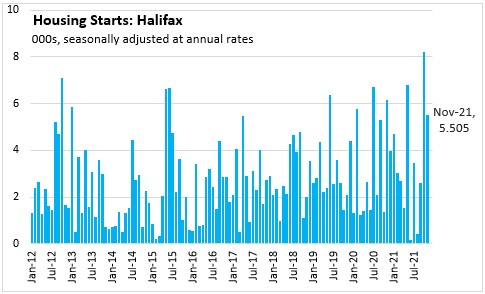

Since 2018, Nova Scotia's housing starts have reported three periods of elevated activity: summer and fall of 2018, summer and fall of 2019 and summer 2020 through spring 2021. These increases in the 6 month moving average of housing starts largely reflect activity in the Halifax market. Outside Halifax, there have been three different periods of elevated housing starts: spring through fall of 2018, fall 2019 through spring 2020 and winter through fall 2021.
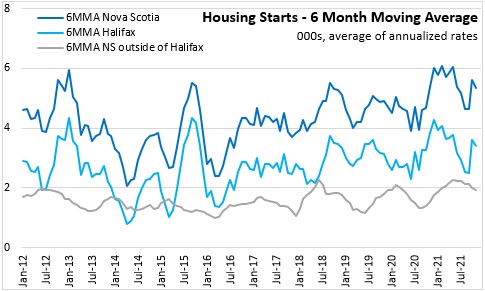
In urban areas, housing starts for multiples are generally higher than for singles with greater variability in the six-month moving average of seasonally adjusted annualized rates. The six-month moving average for both singles and multiples increased in early 2021 and then slowed over the summer. In the fall of 2021, there has been renewed growth in starts for single dwelling units while multiple unit starts remain below their prior 6 month moving average.
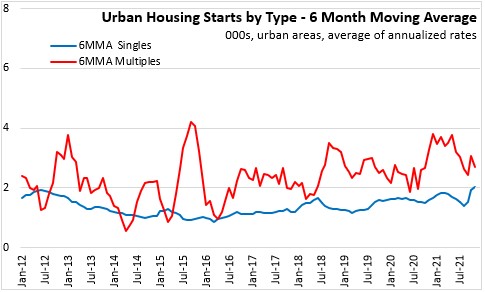
In Canada, housing starts increased 26.4% from October to 301,279 units in November 2021 (seasonally adjusted annualized rate), a rebound followng 5 consecutive months of slowing housing starts. Housing starts were up in 7 provinces, led by New Brunswick (58.8%) and Ontario (55.7%). Starts were down in the other three Atlantic Provinces, with the largest decline reported in Nova Scotia (-23.4% from a recent high in October).
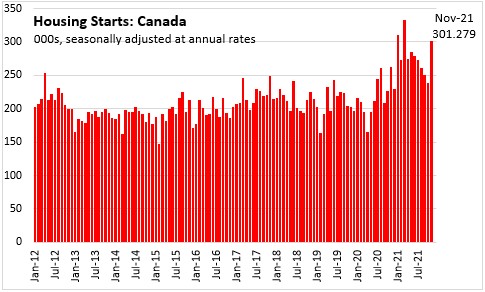
During the first eleven months of 2021, Nova Scotia's housing starts were up 16.7 % compared to the same period in 2020. Halifax housing starts increased 10.3% while starts outside the city were up 29.6%. Canada’s housing starts increased 28.5%. Housing starts rose in all provinces with Newfoundland and Labrador posting the strongest growth (+63.8%), and Manitoba (+8.3%) the slowest.
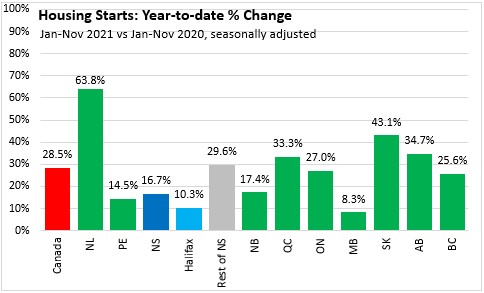
 Note: Urban areas are defined as areas over 10,000 people
Note: Urban areas are defined as areas over 10,000 people
Source: Statistics Canada, Table 34-10-0135-01 Canada Mortgage and Housing Corporation, housing starts, under construction and completions, all areas, quarterly; Table 34-10-0158-01 Canada Mortgage and Housing Corporation, housing starts, all areas, Canada and provinces, seasonally adjusted at annual rates, monthly (x 1,000) ; Table 34-10-0156-01 Canada Mortgage and Housing Corporation, housing starts in all centres 10,000 and over, Canada, provinces, and census metropolitan areas, seasonally adjusted at annual rates, monthly (x 1,000)
<--- Return to Archive